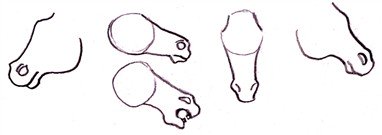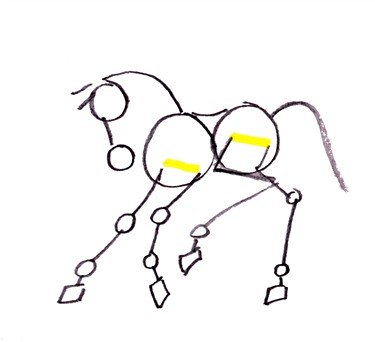Drawing A Horse Head Step by Step
Learn to Draw Front View, Side View and a 3/4 View
When I’m drawing a horse I often start with the head. This lesson will focus on how to draw a horse’s head from any angle. The head is really very simple to draw when you break it down into easy steps.
Whether you are drawing a side view, front view, ¾ views or any other angle; the same rule applies. Start with two circles. One circle will represent the jaw and forehead area. A second circle will represent the muzzle.
These two circles give you a starting point from which to work. They act a wonderful guideline to place other parts of the horse head and they help to keep everything in proportion.
When you are drawing these two circles keep in mind how big they are in relation to one another and how far apart they are. The sizes and distance between the two circles will be different for different horses.
For example, a foal will have a small forehead and a small muzzle. The muzzle and forehead of a pony are going to be closer together than that of a thoroughbred horse. A heavy draft horse will have a large muzzle compared to that of a quarter horse. Of course you don’t have to draw any particular breed at all, but it is nice to know how to when you want to.
Drawing a Horse Head - Different Angles

Once you have your first two circles drawn you can draw the face. Notice the very simple lines needed to complete the shape of the face using the circles as guides. At a side view the face can be a shown with a strait line for most horses. Dish the line in for an Arabian or make it a roman nose for a draft breed. Have fun with it.
Look closely at the lines needed for a 3/4 view. Part of the brow bone will will come into view. The length of the face will appear shorter and the jaw will be more prominent.
Drawing a Horse Head – The Muzzle
A horse may have a bony face, but they have a very soft fleshy muscular muzzle. If you have had the pleasure to watch horses you know that they use their upper lip much like an elephant uses their trunk. Horses do all sorts of things with their lips, like letting them and droop down, pinching them tight when they are irritated or barring their teeth.
The muzzle is an opportunity to show expression on your horse. Wide nostrils show excitement and energy. Pinched nostrils show anger. A relaxed nostril shows a hose at rest. When visible draw the chin too.
5 More Horse Drawing Lessons
Drawing a Horse Head – The Ears
Horses talk with their ears! If there is any body part that will show expression on your horse, it’s the ears. Ears perked forward show attention to something up ahead. Ears flopping sideways show relaxation. Ears pinned flat to the skull show anger.
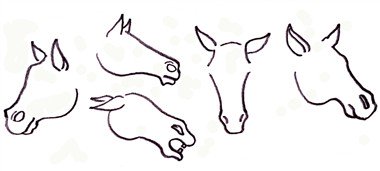
The ear itself is shaped like a tear drop. It sits atop a ‘ball’ that rotates the ear around this way and that, like a set of radars. The ball at the base of the ear is often hidden from view by the mane and forelock (a horse’s bangs)
Play around with different ear positions to see how they change the expression of your horse. Remember to draw the ear on the far side of the horse’s head a bit smaller, as it will be farther away, partially hidden from view or not seen at all.
Drawing a Horse Head – The Eyes
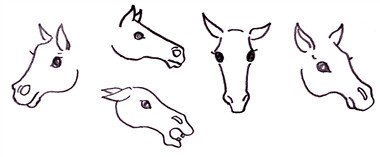
Horses have very large round eyes that are placed far apart. Just above each eye, between the eye and the ear they have an indention. Show this with a small curved line if you wish. Circles or wide almond shapes work well for the eyes. I like to give my horses eyelashes. Play around with different eye shapes and notice how it changes the expression.
Drawing a Horse Head - Adding Realism
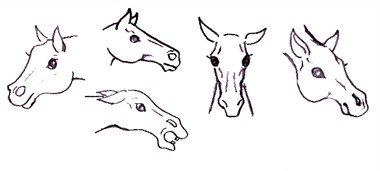
There are several bony parts of a horse’s skull are visible just under the skin. The jaw, the sockets above the eyes, the cheek bones and the long fine nasal passages that run down the horses face. Including these bones in your drawing will bring realism to your horse drawing.
You don’t have to actually draw these bones. Just hint at them with simple lines. You do not even have to do all of them. Depending on the angle of the head you may only choose to indicate one or two. Do more if you feel you want a lot of detail or more realism.
Drawing a Horse Head – The Mane
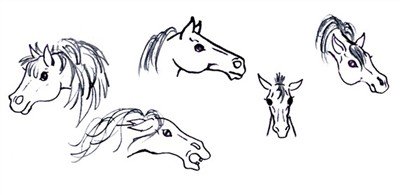
Your horse would not be complete without a mane. It’s the crowning glory. Think about how the mane would be if the horse were running, grazing or standing still. Have fun with it. This is yet another chance to give your horse character and let your artistic style show through.
I like to draw my manes wild and wind blown, but the soft baby hair of a new foal or the braided mane of a show pony can be just as exciting. Play with it. Try using the flat side of your pencil lead for a different effect.
More Articles on Drawing Horses:
Drawing Horses
If you can draw circles and simple lines you can draw horses. Grab a paper and pencil and let’s get started…
Drawing Horses in Action
When you show movement in a drawing your whole picture will come to life. So let’s get started…
Home > How To Draw A Horse > Drawing a Horse Head

